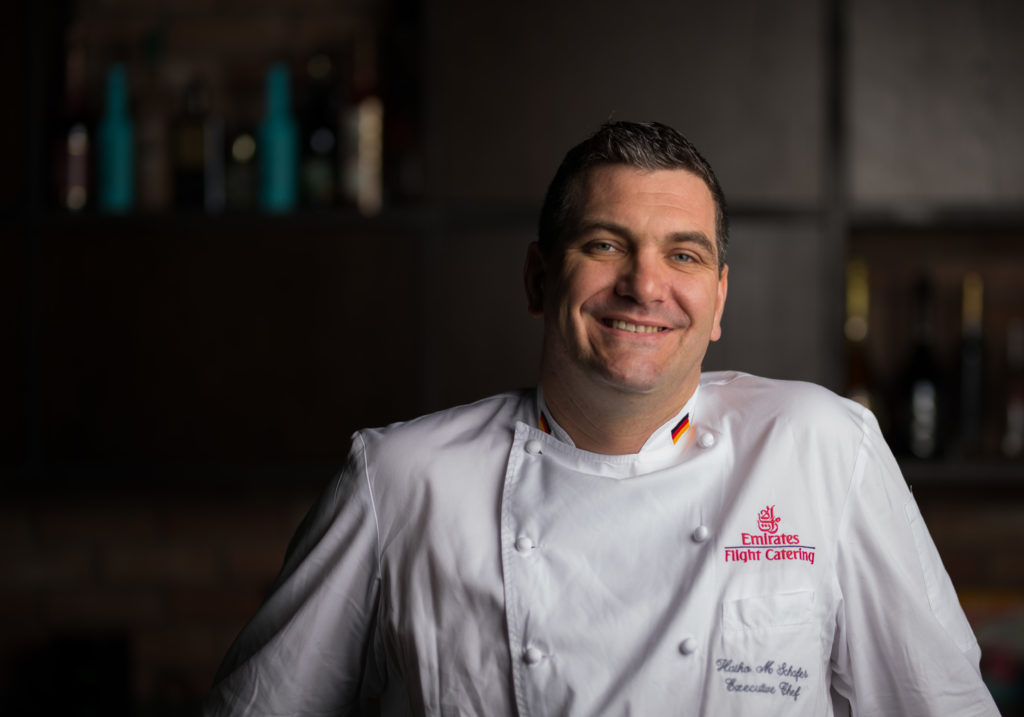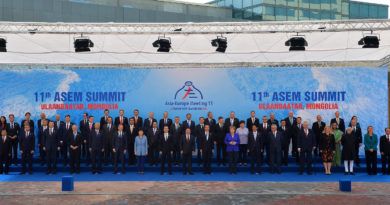Emirates: a flying restaurant in the sky
It is feeling all-too familiar to many airline passengers.
You’re cruising at 34,000ft but get that sinking feeling when the meal is delivered. Bread past its best, soggy omelette and tasteless beef often leave you feel rather underwhelmed.
Happily, there’s at least one airline that’s doing its best to dispel all those traditional myths about airline food. With its emphasis on quality and determination to serve restaurant-style food, Emirates really is flying the flag for the airline industry.
I was granted a rare, behind-the-scenes peep at the secret of its culinary success. This came in the shape of a personal guided tour of what is known as the airline’s “Mother Station” – the amazing flight catering facility at Dubai.
This is where tens of thousands of airline meals are prepared and – regularly throughout each day – sent on their way around the globe. The size of several football pitches, it is probably the biggest of its kind in the world.
With hairnet and pristine coat in place, you are whisked through security and through the doors into what is an amazing hive of activity, a genuine 24-hour operation.
First, the statistics are staggering: the centre is where – each day- 3m items of dirty equipment are sorted and cleaned.
My guide, Glory Kinyua, an operations manager for Emirates, explains that economy-class equipment and business-class equipment are washed separately.
This isn’t anything to do with snobbery but simply because some of the equipment is made from different material.
Workers load everything into a hangar on one side which is then taken to the “ware-wash” machines on another side for hygiene reasons. Each day, some 2m pieces of equipment is washed in 28 washing machines. While the dishes, glassware and cutlery are cleaned and separated, a 2.3km monorail takes the cleaned items to the food area on the first floor – where restaurant-class food is produced on an industrial scale.
Overseeing the preparation of 180,000 meals each day is a team of five executive chefs and sous chefs. During peak periods such as the summer this figure rockets, with the 2017 record in July when 220,000 meals were processed in a 24-hour period.
Like everything else at the Emirates Flight Catering Centre (EKFC), this is undertaken with military-style precision.
The airline boasts a global spread of destinations and also sources ingredients used in its dishes from around the globe.
There are bananas from the Philippines, lamb sourced from New Zealand, vegetables from the Middle East and locally-sourced meat. Oh, and not forgetting (still popular) baked beans from the UK.
Care is taken to ensure that the food that leaves the centre is “route specific.” That means, for example, that sushi dishes are served on its Far East routes while meat (chicken/beef) is the most common (and still most popular) item found on flights to Europe,North America and Australia.
The same criteria applies to wine with the tipple served on, say the Japan route is different to the US one. Each day, 2,300 containers packed with wines leave the centre for loading onto aircraft. That is, apart from flights to nearby Saudi Arabia which are strictly non-alcoholic (any contraventions could land the airline with a huge fine).
Again, there’s a separate area where drinks for business and first class passengers are sorted. As you’d expect these include some very fine champagnes and liquors (as well as that little special touch such as Belgian chocolates and waffles!).
Absolutely nothing is left to chance: even the packed sandwiches now contain full information on their nutritional value/content.
There are also no less than 26 “special” meals, for example for religious or dietary reasons, prepared by 600 staff in the centre’s four kitchens.
Haiko Schafer, originally from Hamburg, is one of five executive chefs who has worked at EKFC for 11 years.
He explained some of the differences between the restaurant in Germany where he used to work and cooking for airline passengers.

Haiko, who works a 5-day week, said, “Actually, I have to admit that when I first arrived I wasn’t sure I would take to it. I came from working in a small restaurant so the sheer size and scale of what we do here took a lot of getting used to. The loss of direct and intimate contact with your customers, was also difficult. Here, you don’t see the people who are eating your meals.”
“Yes,” he concedes, “it was hard at first.”
The 35-year-old adds, “Having readjusted to this type of operation, I have grown to love what I do. For a chef like me it’s the perfect opportunity to work with many different kinds of cuisine. We cook like any other restaurant, just on a very big scale.” By way of illustration, he pointed out that his multi-national team churns out 20,000 cookies per day and 40,000 (fresh) fruit salads for 250 Emirates flights out of Dubai each day.
It takes an estimated 24-48 hours from the point of where work starts on the raw product to where the food enters the aircraft.
“Hygiene,” notes Haiko, “is all important, of course. The last thing we want is for passengers to get sick. But we also have total traceability and know everything on every dish on every flight. We certainly take no risks.”
As good and healthy as the food that comes out of EKFC is, there is, of course, more to being transported from A to B in a metal cigar than just eating. So, as my fascinating tour continues, I find myself in an area full of another traditional ingredient of flying – duty free goods.That perennial favourite – perfume – is apparently still the big seller.
Under the watchful eye of security staff, the goods are carefully guarded and all transactions checked and cross checked.
For all the intense security that nowadays goes with flying, one thing airlines like Emirates still have limited control over, though,is the loss of certain items of on-board equipment such as blankets and plates.
This reminds Glory of the time she saw airline items on sale at a market in her home in Nairobi.
“Some passengers still clearly seem to like to take things as souvenirs. It obviously represents a financial loss to the airline but there’s not a great deal you can do about it,” she observes.
We all like to plunge into the facing pocket for something to read and while away the hours on a long flight and the EKFC area dedicated to printed material is no less fascinating.
It’s here that no less than 225 different magazines and up to 100 different newspapers are sorted and packed.
Attention to detail is, again, the order of the day for instance in ensuring nothing that could be remotely deemed inappropriate material finds its ways into that pocket on a plane.
Recycling is also an important element of the work here, be it cooking oil or aluminium. Every month, the centre recovers 65 tons of cardboard packaging which is recycled (elsewhere in Dubai) into new paper products.
Having opened in 2007, EKFC1 this year celebrates its tenth birthday but is, in fact, just one of two such centres on this sprawling site, located adjacent to Dubai International Airport.
There’s also a EKFC2 facility housing fully-fledged bakery and commissary sections. With current daily production of 500,000 items, these sections are on track to be the largest of their kind under the same roof.
In a city that prides itself on having the tallest building in the world and the only 7-star hotel on the planet, the record-breaking achievements of Emirates’ catering efforts seem entirely appropriate.
In fact, the company’s gastronomy is currently the subject of an unusual promotion here in Belgium.
It has become the only airline to date to be featured on resto.be the online restaurant booking portal in Belgium.
The idea is to showcase its catering capabilities to an even wider international audience and where better than Belgium which reportedly has more Michelin-starred restos per head of population than France.
During the “flying restaurant” campaign, Emirates recipes will be included on the resto.be Facebook page. It all gives an insight into the company’s inflight care and award-winning service.
Not only that, Emirates is also launching an additional daily flight to Brussels in order to cater to the growing demand for travel to the Belgian capital.
Emirates has carried more than half a million passengers between Dubai and Brussels since launching operations on September 5th 2014 and the twice-daily service starts from 29 October.
A spokesman at Belgium’s tourist authority said the company’s operations have made a positive impact on Belgium’s tourism, trade, investment and employment.
The new year-round flight will also enhance Belgium’s global long-haul connectivity, offering passengers travelling from Brussels the chance to reach more than 70 Emirates’ destinations in the Middle East, Africa, Asia and Australasia.
It will also, of course, give even more people a chance to sample the undoubted delights of its fab food!



